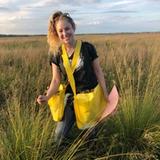Guide to 15 most common weeds in lawns
(This list is actually based on the most common and problematic weeds we see in Sunday customers’ lawns!)
Grass and grass-like weeds
Crabgrass (
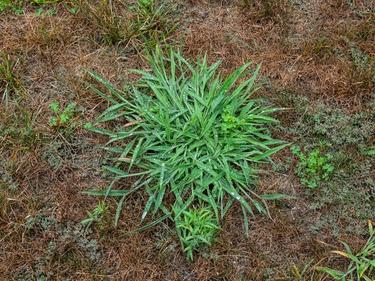
Type of weed: Annual grass
Growth habit: Prostrate growth. Crabgrass can root at the nodes and spread by seed. Tends to come up early and dies off at first frost, leaving bare spots in winter and spring.
Where you’ll find it in your yard: The two common types of crabgrass, smooth and large, can exist in both wet and dry conditions. Generally found in places that are hard to grow healthy (desired) grass like disturbed soils and areas along sidewalks; however, crabgrass is adapted to a wide range of growing conditions, and is common is lawns that are mowed too short or that have bare patches.
Quick ID: Leaf blade is flat and yellow-green, but older leaves may turn reddish or purple. Flower heads have finger-like spikelets and also may turn reddish or purple as they age. Be mindful: This weed is often confused with quackgrass or tall fescue.
Natural weed prevention and reduction practices:
- Pull small patches of crabgrass by hand.
- Raise your mowing height a bit to allow your turf to shade out the crabgrass. Especially in warm-season lawns, you can help prevent crabgrass by allowing grass to grow taller in the fall.
- Seed any bare patches to prevent crabgrass germination. Especially in cool-season lawns, seed early in the fall to avoid fighting weeds in the spring.
Sunday fun fact: Crabgrass actually has the same life cycle as corn. It comes up in the beginning of the season when it’s moist, but when it’s hot and dry, it thrives—just like corn in the late summer!
Sunday product suggestion: Weed Warrior
Annual bluegrass
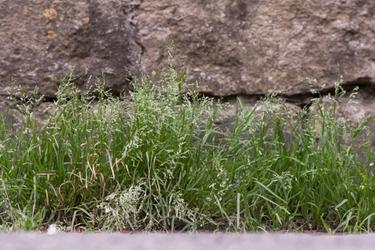
Type of weed: Summer annual grass; while this plant can be perennial, MOST of the time this weed will be an annual plant.
Growth habit: Tufts of grass, extremely shallow rooted, a live fast, die hard approach to growing where the plant isn’t invested in growing long-term.
Where you’ll find it in your yard: Adapted to a broad range of growing conditions, but mainly found in wet, disturbed, or hard-to-grow grass areas (like high traffic or pet waste), and over-fertilized lawns.
Quick ID: Most of the time people notice it when it’s flowering—usually it's the only grassy plant flowering in a regularly mowed lawn. Other ways to recognize:
- It’s usually the first grass to green up in the spring because it’s a winter annual that germinates from fall seed.
- Mainly lighter, brighter green than most lawn turf.
- Boat-shaped leaf tip.
- Flowers and seed heads are fuzzy panicles and whitish or very light green in color.
Sunday Tip:
How can you tell annual bluegrass from Kentucky Bluegrass? While both types of grass have boat-shaped tips, Kentucky bluegrass will be deep green to dark blueish green in color, doesn’t tend to flower when mowed at the proper height, and grows rhizomatously (not a bunch-type grass).
Natural weed prevention and reduction practices: Annual bluegrass is one of the toughest weeds to control. Why? Because it is a turfgrass, and it likes what your grass likes. If you do see some annual bluegrass pop up, make sure to do the following:
- Cut or mow away annual bluegrass flowers and dispose of them in yard waste.
- Hand-pull or treat large patches with weed control, then plant grass in the weeded areas.
- Mow at the proper height for your grass type.
- Audit and check your irrigation system to determine if you are over- or under-watering.
Sunday Tip:
When removing annual bluegrass flowers, you are usually instructed to dispose of the flowering heads. Try to limit this method to localized areas of the lawn where the infestation is very dense. Why? Since you are disposing of these grass clippings, you will also be removing critical nutrients from your soil (learn more about grasscycling).
Sunday product suggestion: Weed Warrior
Goosegrass
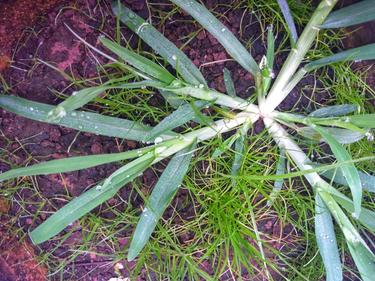
Type of weed: Summer annual grass
Growth habit: Clumped, bunch-type grass
Where you’ll find it in your yard: Goosegrass prefers warmer temperatures than crabgrass and needs moist soil to establish. It also does well in compacted, low quality, under-fertilized soil.
Quick ID: Characterized by zipper-like seed head with small black seeds. Can look similar to crabgrass, but goosegrass is usually white or silver in the center of the plant.
Natural weed prevention and reduction practices: Goosegrass is another weed that thrives in moist soil. Here’s some ways to remove without chemicals:
- Try cutting back on irrigation after hand-weeding (or digging up) goosegrass clumps.
- The best way to avoid an infestation is to utilize resilient grass seed blends to fill in bare patches so annual weeds can’t move into bare soil.
Sunday Tip:
If you have a large population of well-established goosegrass in your lawn, the best thing you can do is wait until it gets cooler and fix those areas of the lawn with Sunday grass seed to make those areas more competitive to weeds.
Sunday product suggestion: Currently, no Sunday products are available to control this weed. We recommend physical removal and preventative measures when possible.
Dallisgrass
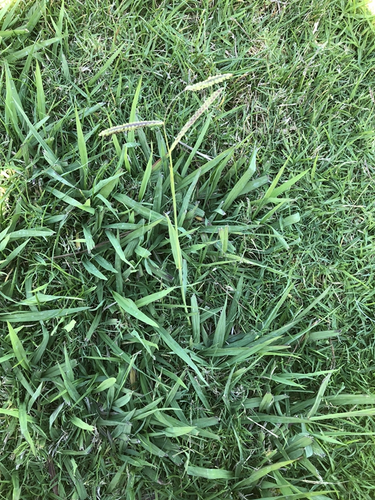
Type of weed: Perennial grass
Growth habit: Clumpy, but can produce short, thick rhizomes
Where you’ll find it in your yard: Typically found in areas where grass is not well maintained and in trouble.
Quick ID: Very coarse (broad) leaves, compared to most turfgrasses. Seedheads have tiny black flowers.
Natural weed prevention and reduction practices: If you do get a heavy Dallisgrass infestation, the best way to deal with it is:
- Dig up the clumps with a shovel
- Reseed the area to ensure you get some healthy turf coverage back.
- Treat similarly to crabgrass (even though a perennial)—raise your mowing height and crowd this weed out!
Sunday product suggestion: Currently, no Sunday products are available to control this weed. We recommend physical removal and preventative measures when possible.
Sedges
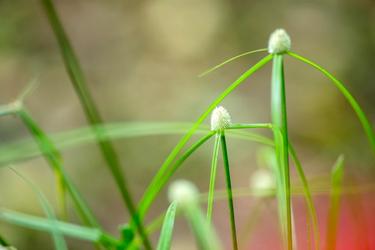
Type of weed: Perennial grass-like (but not actually a grass!)
Growth habit: Upright; spreads by rhizomes, seed, and root systems called “nutlets” (tubers)
Where you’ll find it in your yard: Common in wet areas and may also show up where new soil was transplanted or new sod was introduced into the lawn. Also known to bring in nutsedge: topsoil, adding nursery plants to the landscape, compost from unknown sources.
Quick ID: Sedges closely resemble grasses, but a key identification feature is their triangular stems and underground nutlets! Even commonly referred to as “nutgrass” because sedges look so much like grass at first look.
Natural weed prevention and reduction practices:
- Sedges love warm, humid soggy soil, so reduce irrigation to help dry out the soil.
- When hand-weeding, make sure you remove the nutlets from the soil, or they’ll grow back!
Sunday Tip:
Need help determining if you have a sedge or a grass? Look at the stem! Sedges have edges, rushes are round, and grasses are hollow—what have you found?
Sunday product suggestion: Nutsedge is incredibly difficult to control. Currently, no Sunday products are available to control this weed. We recommend physical removal and preventative measures when possible.
Broadleaf weeds
Dandelion
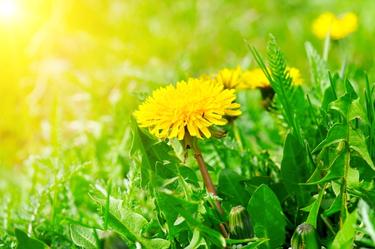
Type of weed: Perennial broadleaf
Growth habit: Clumped, with a very deep taproot.
Where you’ll find it in your yard: Adapted to a broad range of growing conditions, but commonly associated with high-potassium and -calcium soils.
Quick ID: Long, broad, slightly to deeply lobed leaves. Each plant has a single yellow flower which turns into a white puff-ball of seeds.
Natural weed prevention and reduction practices: Dandelions can be tough to deal with. They can grow from the deep taproot, so it’s always best to hand-weed dandelions when they are smaller in size and when soils are slightly wet to allow better extraction of the long root!
Sunday fun fact: Dandelion is named for the teeth of the lion, because its leaf margins are so jagged.
Sunday Tip:
If you can, leave your dandelions for the pollinators! These sunny weeds are one of the earliest sources of pollen for insects when they first emerge in the spring. Leave the flower until it begins to set seed and then cut the flowering head off and spot treat with Sunday herbicides.
Sunday product suggestion: Dandelion Doom and Weed Warrior
Prostrate knotweed
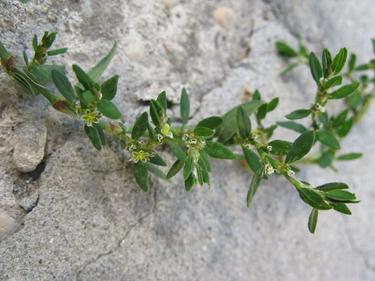
Type of weed: Summer annual broadleaf (same family of plants as rhubarb and buckwheat!)
Growth habit: Prostrate
Where you’ll find it in your yard: Adapted to a broad range of growing conditions, but commonly found in compacted soils and high-traffic areas near driveways and sidewalks. Usually one of the first weeds to come up in the spring!
Quick ID: Blue-green alternate leaves. An ocrea (membranous sheath) surrounds the stem at the base of the leaf, and radiating stems have many swollen nodes. Flowers are small and white. Prostrate knotweed has a long, thin taproot.
Natural weed prevention and reduction practices:
- Knotweed loves compacted soils, so consider aerating soil.
- You can also try to reduce traffic in knotweed-prone areas, where the soil can’t maintain grass growth.
- Hand-pull knotweed before it seeds, and patch any bare spots with turf seed.
Sunday Tip:
This weed is critical to take care of. Because it is a summer annual, it will die off early in the season, leaving behind a bare spot in the soil open for new weeds to move in.
Sunday product suggestion: Dandelion Doom*
White clover
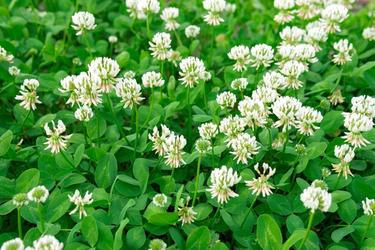
Type of weed: Perennial broadleaf legume, active throughout the growing season
Growth habit: Low growing, creeping, growth; can root at nodes
Where you’ll find it in your yard: Adapted to a broad range of growing conditions, but can be worse when it’s hot and dry
Quick ID: Three rounded leaves—also known as trifoliate leaves (unless you’re lucky and find a four-leaf!); often, leaves will have white “watermarks” known as white corona. Flowers are sphere-shaped and white, often with a pink base.
Natural weed prevention and reduction practices:
- Pull clover by hand.
- Mow off flowers before they seed (this is best done in the early morning to avoid harming pollinators!)
- Clovers thrive in low-nitrogen, high-phosphorus soils, so adjust fertilization based on soil tests!
- If you let it grow tall, this plant doesn’t tolerate drastic cutting (the one time it’s a good idea to violate the ⅓ rule!).
Sunday Tip:
Clover is not always a weed. It’s an incidental flowering plant that is great for the bees, and can be good for the lawn too! Clover is a legume and a nitrogen-fixer so you might notice the grass near the clover is darker. Bonus? High populations of clover can also help eliminate crabgrass problems in the lawn. Win-win.
Sunday product suggestion: Dandelion Doom or sometimes Weed Warrior*
Creeping Charlie (Ground ivy)
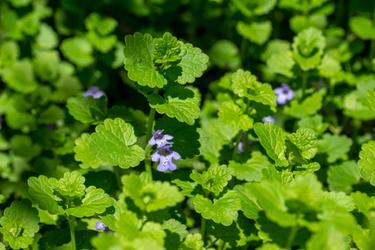
Sunday Tip:
Mule Team Borax applied at full bloom or after the first frost can provide some control of Creeping Charlie.
To treat 1,000 square feet, use 10 ounces of Mule Team Borax, dissolve in 4 ounces of warm water, then dilute in 2.5 gallons of water.
Sunday fun fact: Creeping Charlie is also known as Gill on the Ground, and in parts of the midwest it’s used to make beer!
Sunday product suggestion: Dandelion Doom*
Henbit
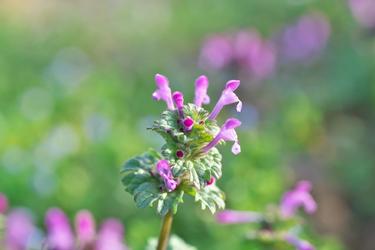
Type of weed: Winter annual broadleaf
Growth habit: Prostrate
Where you’ll find it in your yard: Prefers moist to wet soils
Quick ID: Greenish purple four-sided stems with egg-shaped, toothed leaves. Flowers are reddish-purple and look like tiny orchid flowers with dark red spots.
Natural weed prevention and reduction practices:
- Hand-weeding and proper irrigation should help control henbit.
- The best time to manage any type of winter annual is in the fall when they first emerge—if you see in the spring it’s too late to manage. But don’t worry! By that point, they’re going to die-off anyways when temperatures warm up.
Sunday fun fact: Hens aren’t the only creatures to like this little plant! Henbit is very popular with and great for pollinators too!
Sunday Tip:
Henbit and purple deadnettle look very similar (they’re closely related!) but purple deadnettle’s upper leaves have petioles (tiny stems) and are usually purple-tinted, while henbit’s upper leaves are attached directly to the stem.
Sunday product suggestion: Currently, no Sunday products are available to control this weed. We recommend physical removal and preventative measures when possible.
Common chickweed
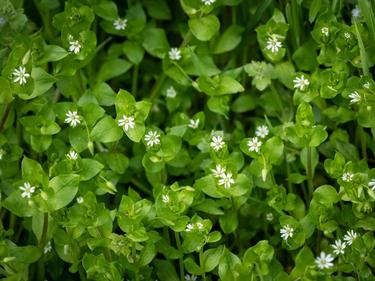
Type of weed: Summer or winter annual broadleaf
Growth habit: Creeping, so much so that it tends to creep into sidewalks and flower beds, and can even grow right on top of the grass on your lawn
Where you’ll find it in your yard: Prefers cool, moist-to-wet conditions and compacted soils
Quick ID: Small, oblong, pale green leaves with hairy stems; white star-like flowers
Sunday fun fact: Chickweed is a member of the Pink family and has the characteristic swollen nodes and opposite leaves.
Natural weed prevention and reduction practices: Since chickweed prefers moist soil, try adjusting how you water your lawn! Deep, infrequent irrigation can help fight water-loving weeds like chickweed.
Sunday Tip:
There’s actually another type of chickweed called Mouse-Ear Chickweed. This is a perennial weed that is found in lawns that are in bad shape and may signify you have an under-fertilized, improperly watered lawn. How to tell the difference: Mouse-ear chickweed likes dry conditions, and common chickweed likes wet conditions.
Sunday product suggestion: Weed Warrior , sometimes Dandelion Doom
Field bindweed
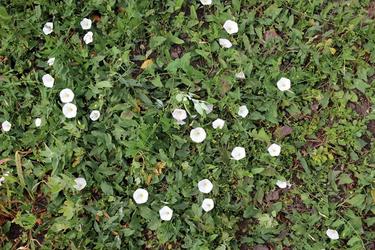
Type of weed: Perennial broadleaf (in the morning glory family!), very active in summer months
Growth habit: Trailing vine, which grows stronger if lawns are drought-stressed and poorly fertilized; generally a sign that a lawn is in trouble
Where you’ll find it in your yard: Adapted to a broad range of growing conditions, but common in dry soils. Especially fond of dry, well-drained areas like slopes, and south or west-facing lawns. One of the most difficult to control perennial weeds—while you can eliminate weeds at the surface, it has an extensive underground root system (up to 8-9 feet deep!).
Quick ID: Triangular or arrow-shaped leaves; flowers are white to pale pink and look like mini morning glory or petunia flowers. Bindweed is often confused with red sorrel, but that weed is an indication of wet conditions, not dry.
Natural weed prevention and reduction practices:
- Hand pull as soon as you see it. Bindweed reproduces by seed and broken root fragments, so make sure you remove underground stems when you hand-weed!
- Continue to remove vines as needed, and monitor regularly.
Irrigate properly. This weed also likes dry soils, so make sure you are irrigating enough to keep your turf healthy!
Sunday Tip:
Bindweed is more noticeable in summer months during dry conditions when mowing is skipped and it’s able to flower in the lawn. It cannot tolerate frequent mowings—when it gets taller you can then mow to reduce its growth and spread.
Sunday product suggestion: Currently, no Sunday products are available to control this weed. We recommend physical removal and preventative measures when possible.
Black medic
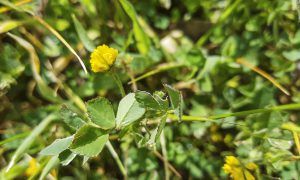
Type of weed: Annual broadleaf legume (which means it can fix its own nitrogen!)
Growth habit: Taproot, with spreading, prostrate growth
Where you’ll find it in your yard: Adapted to a broad range of growing conditions. Often appears in summer and in dry, well-drained soil. Especially fond of areas of lawn where grass isn’t actively growing and soil cannot hold water due to dry conditions.
Quick ID: Three rounded leaflets; flowers are small, yellow and bunched; seed pods are black grape-like clusters.
Lookalike alert! Black medic and clover look very similar when they aren’t flowering. So how can you tell them apart?
- White clover leaflets are all equidistant from the main stem, while the petiole (small leaf stem) of the central leaflet on black medic is slightly longer than the two on either side.
- Plus, black medic has a distinct “spur” at the tip of each leaflet. Yee-haw! (Or should we say “bee-haw!” since black medic is highly attractive to bees and other pollinators!)
Natural weed prevention and reduction practices:
- Hand-weeding trouble spots is usually effective.
- Black medic is a prolific seed producer—try to remove plants (especially flowers) before they seed.
Sunday product suggestion: Dandelion Doom**
Woodsorrel
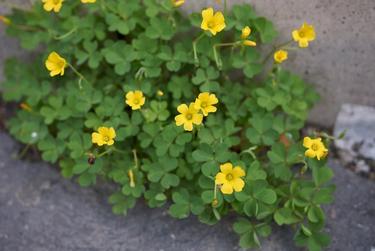
Type of weed: Broadleaf weed that can be a summer annual in the north or a perennial in the south; commonly called oxalis
Growth habit: Similar growth habit to clover; reproduces by seed, germinates from spring-summer, and has very shallow roots
Where you’ll find it in your yard: Adapted to a broad range of growing conditions but typically appears in hot temperatures during summer and invades areas that get very wet or very dry. Can be present in areas where water might collect, but over time areas that also can’t maintain water.
Quick ID: Hairy stems with distinct three-heart-shaped leaflets per leaf. Leaflets may fold in half in the heat or at night. Flowers are five-petaled and yellow.
Natural weed prevention and reduction practices: Woodsorrel is easily removed by hand, so roll up your sleeves, give it a yank, and save the chemicals for when they’re really needed!
Sunday fun fact: Woodsorrel is a flowering plant that produces a dehiscent seed that opens with ripe. Woodsorrel seed pods split from pressure and spread seed through this ballistochory movement.
Sunday product suggestion: Dandelion Doom
Moss and algae
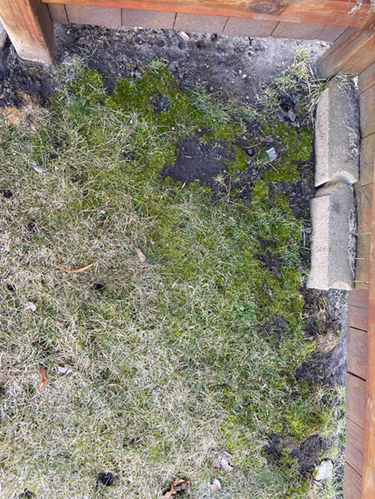
Type of weed: Moss—these are not like any other plant on this list because they are non-vascular. These are more like fungi than other plants.
Growth habit: Low-growing
Where you’ll find it in your yard: Damp or wet shady areas and in bare soil between grass plants
Quick ID: Very small black, green, or yellow-green leaves with a sponge-like or slimy texture.
Natural weed prevention and reduction practices:
- Moss and algae are common in wet, shady areas with thin turf—so, reduce irrigation and seed bare, shaded areas with a shade-tolerant turf.
- If you have dry areas with moss, here’s why: At some point this area had too much water. Sometimes moss persists due to age and longevity of growth. This type of moss will need to be removed physically (or with Sunday Dandelion Doom).
Sunday Tip:
Large populations of moss within your lawn is an indicator that this isn’t the best place for grass. This area would be perfect for a rock garden, patio, or another use. Bonus tip: if you remove the moss, place in a blender with buttermilk and then pour over your new rock garden—the moss will re-establish itself.
Sunday product suggestion: Dandelion Doom* or Weed Warrior
*Not currently registered for this weed in California
**Approved for suppression of this weed in California
How to prevent weeds in your lawn
At Sunday, we believe in working smarter, not harder. Our Integrated Pest Management (IPM) approach helps you tackle weeds effectively while keeping your lawn naturally healthy.
Prevent with the basics
- Maintain proper mowing height
- Water deeply but infrequently
- Keep soil healthy with the right nutrients
- Overseed thin areas and bare spots
Detect weeds early
Walk your lawn regularly and learn to identify common weeds.
Once you know the weeds in your lawn, look for patterns in problem areas and continue to document what you find.
Sunday Tip:
Psst. This is a great activity to do with the kids!
Repair problem areas
- Divide your lawn into sunny vs. shady areas
- Check for drainage issues
- Identify high-traffic zones
- Test your soil —sometimes the problem is here
Remove weeds
Start with hand-pulling large weeds—anything over 5 inches tall or wide. If you have an extremely weedy lawn, try mowing weeds and overseeding.
Opt for Sunday weed control products for weed prevention, younger weeds, and smaller patches of weeds.
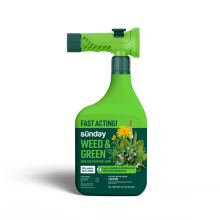
Weed & Green Pre-emergent and Post-Emergent Weed Killer
- Prevents crabgrass & weeds
- Controls moss, algae & lichen
- Suppresses lawn disease
- Greens up lawn quickly
- Derived from iron (Fe)*
- Made for all lawns

Dandelion Doom Lawn Weed Killer - Starter Pack
- Controls lawn weeds & moss
- Kills weeds down to the root
- Safe for use on lawns
- Fast-acting Iron (Fe) formula
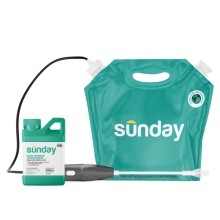
Weed Warrior Weed & Grass Killer - Starter Pack
- Organic herbicidal soap
- Kills weeds, grass, moss & algae
- See same-day results
- Perfect for walkways & mulch
Monitor and adapt
Track which solutions work best. Adjust your strategy as needed, keep notes, or take pictures for future reference—and most importantly, celebrate your progress!
Weed ID guide terminology
Know the 4 common weed types
- Grassy weeds: These lawn lookalikes blend right in at first! Think crabgrass and dallisgrass that disguise themselves among your turf.
- Broadleaf weeds: The easiest to spot thanks to their flowers and broad leaves. Common culprits include dandelions, clover, and henbit.
- Sedges: Remember this tip: "Sedges have edges!" These grass imposters give themselves away with their triangular stems.
- Moss or algae: These low-growing plants are moisture-lovers that typically signal drainage issues in your lawn.
Most weeds in this guide generally fall into the grassy or broadleaf category.
Learn weed life cycles
Knowing how weeds grow is the key to managing them! Most lawn weeds fall into two main categories:
- Annual: These fast-growing weeds pop up when conditions are just right, complete their life cycle, and die within one season—but leave behind seeds for next year.
- Perennials: These persistent plants come back year after year from the same root system. They require a bit more strategy to manage effectively.
Cited sources
Borax on Ground Ivy: Boon or Bane?Iowa State Extension.
Category: Weed of the Month. University of Purdue Extension.
Is this plant a weed?University of Minnesota.
Turf Weeds and Their Control. Turgeon, A.J.
Turfgrass Weed Control for Professionals. Patton, A. et al., Purdue University Extension.
Weed Control Options for Residential Lawns in Utah. Utah State University Extension.
Weed Identification | OWL. OARDC Weed Lab, The Ohio State University.


